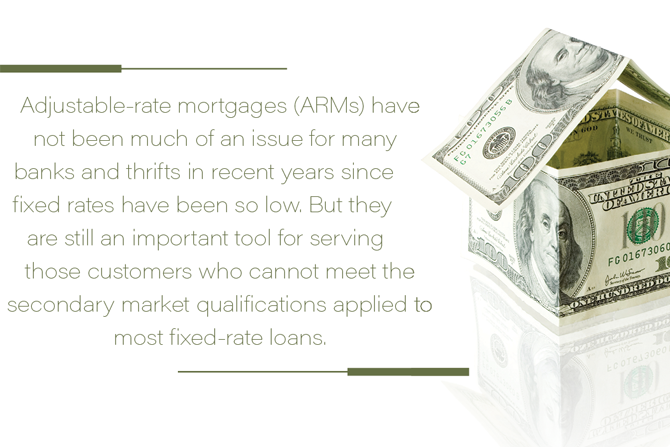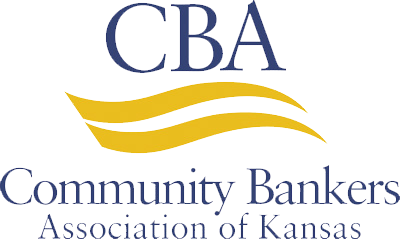By William J. Showalter, CRCM, CRP Senior Consultant; Young & Associates, Inc.; Kent, Ohio

Adjustable-rate mortgages (ARMs) have not been much of an issue for many banks and thrifts in recent years since fixed rates have been so low. But they are still an important tool for serving those customers who cannot meet the secondary market qualifications applied to most fixed-rate loans. Also, many institutions have a portfolio of existing ARM loans that they service. One potential complication for some lenders is the impending discontinuance of the LIBOR index, requiring them to find another comparable index for their ARMs.
ARMs were in the spotlight over 10 years ago because of problems in the subprime market. Many subprime products have variable interest rates, which shift the interest rate risk from lender to borrower. Besides the issues raised then over putting borrowers into inappropriate products, there also are concerns over errors in ARM rate changes.
Do an internet search for “ARM errors” or similar terms, and you will come up with numerous firms offering loan audit and information services to borrowers. These firms tell borrowers that their companies can correct ARM errors, bring loans into compliance and get the borrower a mortgage refund.
Background
The initial furor over these mistakes arose over a report on ARM adjustment errors prepared by a former Federal Savings and Loan Insurance Corporation employee in 1989. His assertions sent a tremor through the mortgage industry. The report concluded that miscalculations in periodic adjustments to rates on ARM instruments resulted in significant overcharges. He found ARM adjustment errors in about 50% of the loans he sampled. From these results, he estimated the potential overcharges to be up to $15 billion for ARMs nationwide at the time. This figure has been estimated as high as $50-60 billion in recent years.
The controversy was further stoked by a study from the Government Accountability Office (GAO), released in September 1991, which found between 20-25% of the ARM loans at the time contained interest rate errors. Such errors occurred when the related mortgage servicer selected the incorrect index date, used an incorrect margin or ignored interest rate change caps.
The damaging studies kept coming. In July 1994, Consumer Loan Advocates, a non-profit mortgage auditing firm, announced that as many as 18% of ARMs have errors costing the borrower more than $5,000 in interest overcharges. Also, another government study in December 1995 concluded that 50-60% of all ARMs contain an error regarding the variable interest rate charged to the homeowner. The study estimated the total amount of interest overcharged to borrowers was in excess of $8 billion. Inadequate computer programs, incorrect completion of documents, and calculation errors were cited as the major causes of interest rate overcharges.
Even though no other government studies have been conducted into ARM interest overcharges to date, the potential issue continues to simmer below the surface, and lenders need to be vigilant so that it does not erupt into a veritable supervolcano of enforcement actions and lawsuits.
Types of errors
The kinds of errors lenders are said to make in implementing ARM rate and payment adjustments run the gamut from calculation mistakes to carelessness, including:
- Mistakes in the original loan setup/data input
- Miscalculation of the payment amount
- Improper allocation of payments between interest and principal (amortization)
- Use of the wrong index
- Selection of an incorrect index value
- Application of incorrect interest
rate caps - Failure to adjust in some years
- Use of incorrect margins
- Improper rounding methods (e.g., rounding up instead of rounding to the nearest 1/8th of 1 percent)
- Math mistakes causing an
incorrect rate - Use of an incorrect loan balance
Banking regulators point out that these errors may be considered breaches of contract and could expose the financial institution to legal action.
Extent of errors
Since ARMs involve changing index values periodically and complex computer calculations, they seem to attract human and software errors. Mortgage audit firms point out that leading publications such as The Wall Street Journal, MONEY, Forbes and Newsweek have warned borrowers about miscalculations occurring in up to 50% of ARMs.
The firms get borrowers’ attention by pointing to figures of lender overcharges and borrower refunds like these:
- Average borrower refunds of over $1,500
- 21% of refunds ranging from $3,500 to $10,000
- 13% of errors exceeding $10,000

Reasons for errors
The calculation of ARM rate changes is a complex process, and errors can occur in a variety of ways. Add to this the fact that many lenders offer, and servicers support, a variety of ARM products with different rate adjustment intervals, indices, margins, and other terms. Another potential complicating factor is the widespread practice of transferring loan servicing, presenting another opportunity for human mistakes and software mismatches to cause errors.
In addition, some of the mortgage audit firms assert that ARM rate and payment adjustment errors have been linked to:
- Lack of training, supervision and experience of loan servicing personnel
- Simple human error
- Computer data entry or software errors
- Clerical or calculation errors
- Fraud
- Sale or transfer of the loan to a different company
- Riders, handwritten changes, or other irregularities in the note
- Very complex calculations or use of an unusual index or interest rate
- Dissolution or merger of the original loan institution
How to avoid these problems
The federal banking supervisors began encouraging financial institutions back in 1991 to perform reviews of their adjustable rate loan systems to ensure that interest rate information is correctly ascertained and administered, and that rates are adjusted properly.
Banks and thrifts should have effective internal controls and procedures in place to ensure that all adjustments are made according to the terms of the underlying contracts and that complete, timely, and accurate adjustment notices are provided to borrowers. Also, a system for the ongoing testing of adjustments should be in place to ensure that adjustments continue to be made correctly.
A critical component of any successful loan servicing program, including correctly implementing rate and payment adjustments, is a thorough training regime for lending personnel involved in the process. Those involved must be given the appropriate tools — including knowledge — to succeed in their jobs.
Any review of ARM adjustments should include documentation indicating the basis for interest rate adjustments made to a lender’s ARM loans, showing whether changes have been made that are consistent with the underlying contracts.
If a lender finds that it has made errors in the adjustments for interest rates, which have resulted in interest overcharges on ARMs, the supervisory agencies expect that you will have in place a system to correct the overcharges and properly credit the borrower’s account for any interest overcharges. In general, undercharges cannot be collected from borrowers.

William J. Showalter, CRCM, CRP is a senior consultant with Young & Associates, Inc.
(www.younginc.com), with over 35 years’ experience in compliance consulting, advising and assisting financial institutions on consumer compliance and compliance management issues. He also develops and conducts compliance training programs for individual banks and their trade associations, and has authored or co-authored numerous compliance publications and articles.
Bill can be reached at (330) 678-0524 or wshowalter@younginc.com.
This story appears in Issue 5 2020 of the In Touch Magazine.








